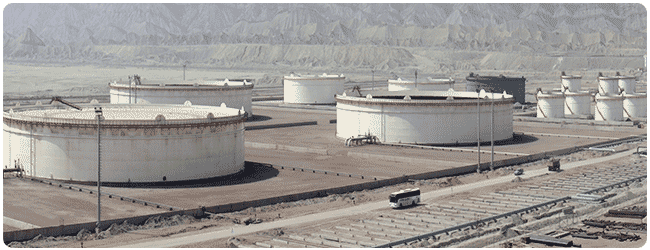مخازن ذخیره به سازههایی اشاره میکند که برای نگهداری انواع مایعات در فشار اتمسفر اطلاق میگردد.
مخازن ذخیره اتمسفریک اغلب به شکل استوانه عمودی یا افقی با کف تخت یا مخروطی یا شیبدار و سقف ثابت یا شناور طراحی میشود. این مخازن به دو دسته زیرزمینی و روزمینی تقسیم میشود. مخازن ذخیره اتمسفریک روزمینی اغلب برای ذخیره سیالاتی مانند بنزین، آب، مواد شیمیایی، سیالات خطرناک و خورنده کاربرد دارد که بر اساس استانداردهای سختگیرانه صنعتی طراحی میشود.
مخازن ثابت ذخیره
مخازن ثابت ذخیره به انواع مخازن هوایی و زمینی جهت ذخیره آب و مواد سوختی و صنعتی در پالایشگاهها، نیروگاهها، پتروشیمیها و سایر مکانهای صنعتی اطلاق میشود. مخازن ذخیره در صنایع پتروشیمی جهت ذخیره مایعات گازی، مواد شیمیایی، آب و غیره استفاده میشوند. مخازن ذخیره دارای فشار کمتر از 15PSI هستند. بطور کلی مخازن ذخیره به دو نوع زیر تقسیم میگردند:

مخازن ذخیره اتمسفریک معمولاً از جنس کربن استیل و یا فولاد آلیاژی برای موارد خاص ساخته میشوند. مواد ذخیره شده در این مخازن باید فشار بخار کمتر از یک اتمسفر در دمای کارکرد داشته باشند. این مخازن معمولاً دارای شیر اطمینان هستند تا از ایجاد اختلاف فشار بیش از حد بین داخل مخزن و فشار اتمسفر جلوگیری گردد.
مخازن کمفشار معمولاً برای ذخیرۀ موادی بکار می رود که فشار بخار آنها از اتمسفر در دمای کارکرد بالاتر باشد . البته فشار داخل مخازن نباید از 15PSI بیشتر شود .